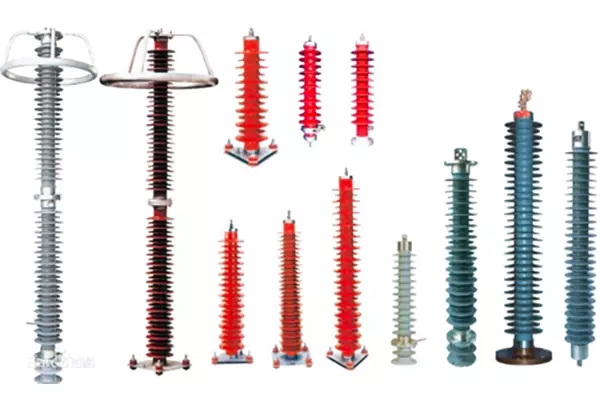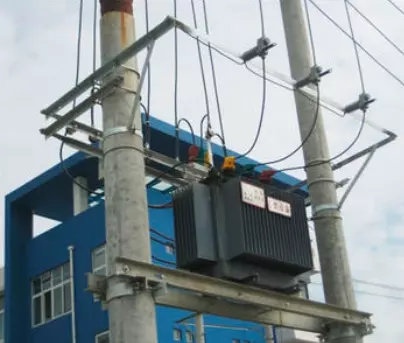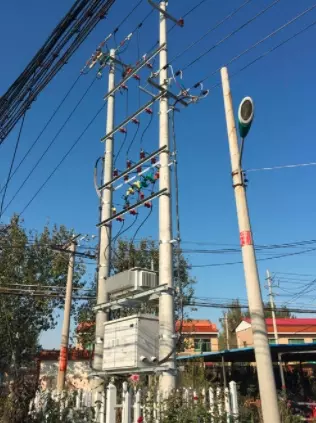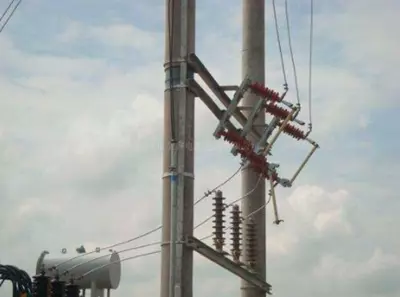The Function of Lightning Arrester
2022-08-12
2020-10-29

Therefore, the main function of the arrester is to clip the intruding flowing wave through the parallel discharge gap or nonlinear resistance, reduce the overvoltage value of the protected equipment, and protect the communication line and equipment.
Lightning arresters can be used not only to protect against high voltages generated by lightning, but also to protect against operating high voltages.
The function of the lightning arrester is to protect various electrical equipment in the power system from damage caused by lightning overvoltage, operating overvoltage, and power frequency transient overvoltage. The main types of lightning arresters include protective gaps, valve arresters and zinc oxide arresters. The protective gap is mainly used to limit the atmospheric overvoltage, and is generally used for the protection of the power distribution system, the line and the incoming line of the substation. Valve-type arresters and zinc oxide arresters are used for the protection of substations and power plants. In 500KV and below systems, they are mainly used to limit atmospheric overvoltage. In ultra-high voltage systems, they will also be used to limit internal overvoltages or as internal overvoltage backup protection.

1. Large current capacity of zinc oxide arrester
This is mainly reflected in the ability of lightning arresters to absorb various lightning overvoltages, power frequency transient overvoltages, and operating overvoltages. The current flow capacity of the zinc oxide arrester produced by JECSANY fully meets or exceeds the requirements of national standards. Indicators such as line discharge level, energy absorption capacity, 4/10 nanosecond high-current impact tolerance, and 2ms square wave current capacity have reached the domestic leading level.
2. Excellent protection characteristics of zinc oxide arresters
Zinc oxide arrester is an electrical product used to protect various electrical equipment in the power system from overvoltage damage and has good protection performance. Because the non-linear volt-ampere characteristic of the zinc oxide valve plate is very good, so that only a few hundred microampere current can pass under the normal working voltage, it is easy to design a gapless structure, so that it has the characteristics of good protection performance, light weight, and small size. When the over-voltage invades, the current flowing through the valve plate increases rapidly, and at the same time the amplitude of the over-voltage is limited, and the energy of the over-voltage is released. After that, the zinc oxide valve plate returns to a high resistance state, so that the power system works normally.
3. The zinc oxide arrester has good sealing performance
The arrester element adopts a high-quality composite house with good aging performance and good airtightness, and measures such as controlling the compression of the sealing ring and adding sealant. The ceramic house is used as the sealing material to ensure reliable sealing and stable performance of the arrester.
4. The mechanical properties of zinc oxide arresters
Mainly consider the following three factors:
⑴ Earthquake force;
⑵ The maximum wind pressure acting on the arrester
⑶ The top end of the arrester bears the maximum allowable tension of the wire.
5. The good decontamination performance of zinc oxide arrester
The gapless zinc oxide arrester has high pollution resistance.
The current level of creepage distance specified by the national standard is:
⑴ Level II medium pollution area: creepage distance 20mm/kv
⑵ Level III level heavy pollution area: creepage distance 25mm/kv
⑶ Level IV, extremely heavy pollution area: creepage distance 31mm/kv
6. The high operating reliability of zinc oxide arresters
The reliability of long-term operation depends on the quality of the product and whether the selection of the product is reasonable. The quality of its products is mainly affected by the following three aspects:
A. The rationality of the overall structure of the arrester;
B. Volt-ampere characteristics and aging resistance characteristics of zinc oxide valves
C. The sealing performance of the arrester.
7. Power frequency withstand ability
Due to various reasons such as single-phase grounding, long-line capacitance effect and load dump in the power system, it will cause the increase of power frequency voltage or the generation of transient overvoltage with higher amplitude; The arrester has the ability to withstand a certain power frequency voltage rise within a certain period of time.
Use of Lightning arrester

The metal oxide arrester (MOA) is connected in parallel with the distribution transformer during normal operation, the upper end is connected to the line, and the lower end is grounded. When an overvoltage occurs on the line, the distribution transformer at this time will withstand the three-part voltage drop generated when the overvoltage passes through the arrester, lead wire and grounding device, which is called residual voltage. Among these three parts of overvoltage, the residual voltage on the arrester is related to its own performance, and its residual voltage value is constant. The residual voltage on the grounding device can be eliminated by connecting the grounding down conductor to the distribution transformer housing and then connecting it to the grounding device. How to reduce the residual voltage on the leads becomes the key to protecting the distribution transformer. The impedance of the lead wire is related to the frequency of the current passed. The higher the frequency, the stronger the inductance of the wire and the greater the impedance. It can be seen from U=IR that to reduce the residual voltage on the lead, it is necessary to reduce the lead impedance, and the feasible way to reduce the lead impedance is to shorten the distance between the MOA and the distribution transformer to reduce the lead impedance and reduce the lead voltage drop. The arrester should be installed at a point close to the distribution transformer.

If there is no MOA installed on the low-voltage side of the distribution transformer, when the high-voltage side arrester discharges lightning current to the ground, a voltage drop will be generated on the grounding device, and this voltage drop will act on the neutral point of the low-voltage side winding at the same time through the distribution transformer housing. Therefore, the lightning current flowing in the low-voltage side winding will cause the high-voltage side winding to induce a high potential (up to 1000 kV) according to the transformation ratio. This potential will be superimposed with the lightning voltage of the high-voltage side winding, resulting in the neutral point potential of the high-voltage side winding Rise, breakdown the insulation near the neutral point. If a MOA is installed on the low-voltage side, when the MOA on the high-voltage side is discharged to raise the potential of the grounding device to a certain value, the MOA on the low-voltage side starts to discharge, so that the potential difference between the outlet end of the low-voltage side winding and its neutral point and the housing is reduced. It can eliminate or reduce the influence of "inverse transformation" electric potential.
3. The MOA ground wire should be connected to the distribution transformer housing
The grounding wire of MOA should be directly connected to the housing of the distribution transformer, and then the housing is connected to the earth. It is wrong to connect the ground wire of the arrester directly to the earth, and then lead another ground wire from the grounding stake to the transformer shell. In addition, the ground wire of the arrester should be as short as possible to reduce the residual voltage.

Conduct regular insulation resistance measurements and leakage current tests on MOA. Once the insulation resistance of MOA is found to be significantly reduced or broken down, it should be replaced immediately to ensure safe and healthy operation of the distribution transformer.
Operation and maintenance of arrester
In daily operation, check the pollution of the surface of the porcelain house of the arrester, because when the surface of the porcelain house is seriously polluted, the voltage distribution will be very uneven. In an arrester with shunt resistors in parallel, when the voltage distribution of one of the components increases, the current through its parallel resistor will increase significantly, and the parallel resistor may be burned out and cause malfunction. In addition, it may also affect the arc extinguishing performance of the valve arrester. Therefore, when the surface of the arrester porcelain house is seriously dirty, it must be cleaned in time.
Check the lead wire of the arrester and the grounding down conductor, there are burn marks and broken strands, and whether the discharge recorder is burned through this inspection, the most likely to find the invisible defect of the arrester; Check whether the sealing of the upper lead of the arrester is good. Poor sealing of the arrester will cause water and moisture to cause accidents; Therefore, it is necessary to check whether the cement joint between the porcelain house and the flange is tight, and a waterproof cover can be installed on the lead wire of the 10 kV valve-type arrester to avoid rainwater infiltration; Check whether the electrical distance between the arrester and the protected electrical equipment meets the requirements. The arrester should be as close as possible to the protected electrical equipment. The arrester should check the action of the recorder after a thunderstorm; Check the leakage current. When the power frequency discharge voltage is greater than or less than the standard value, maintenance and testing should be carried out; When the discharge recorder has too many movements, it should be overhauled; the porcelain house and cement joints are cracked; when the flange and rubber gasket are off, it should be overhauled.
The insulation resistance of the arrester should be checked regularly. When measuring, use a 2500 volt insulation shaker. The measured value is compared with the previous result. It can continue to be put into operation when there is no obvious change. When the insulation resistance drops significantly, it is generally caused by poor sealing and dampness or spark gap short-circuit. When it is lower than the qualified value, a characteristic test should be performed; When the insulation resistance increases significantly, it is generally caused by poor contact or breakage of the internal parallel resistor, loose spring and separation of internal components.
In order to discover invisible defects inside the valve arrester in time, a preventive test should be carried out before the thunderstorm season each year.




